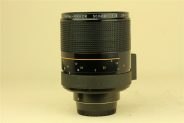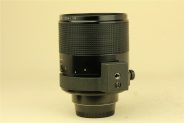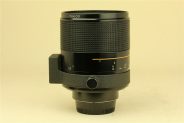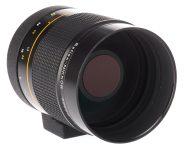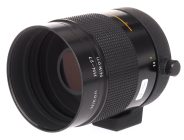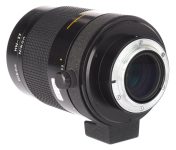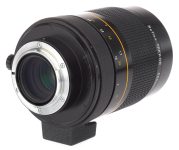Announced
Production status
System
Pros and cons
Genres or subjects of photography
Recommended slowest shutter speed when shooting static subjects handheld
Nikon Reflex-Nikkor 500mm F/8
Super telephoto prime lens • Film era • Discontinued
Model history
| ■Nikon Reflex-Nikkor[·C] 500mm F/8 | -- | 5 - 3 | 4.00m | ⌀88 | 1968 ● | |
| ■Nikon Reflex-Nikkor 500mm F/8 | -- | 6 - 6 | 1.50m | ⌀82 | 1983 ● | |
Specification


| Optical design: | |
| 500mm | |
| F/8 | |
| 35mm full frame | |
| Nikon F [46.5mm] | |
| 5° (35mm full frame) | |
| 6 elements in 6 groups | |
| Diaphragm mechanism: | |
Diaphragm type: | Fixed |
Aperture control: | None |
| Focusing: | |
| 1.5m | |
| 1:2.5 | |
Focusing modes: | Manual focus only |
Manual focus control: | Focusing ring |
| Physical characteristics: | |
| 840g | |
| ⌀89×109mm | |
| Accessories: | |
| Screw-type 82mm | |
| Rear screw-type 39mm | |
| HN-27 - Screw-type round | |
| Nikon Teleconverter TC-14 → 700mm F/11.2 | |
| Nikon Teleconverter TC-14A → 700mm F/11.2 | |
| Nikon Teleconverter TC-14B → 700mm F/11.2 | |
| Nikon Teleconverter TC-200 → 1000mm F/16 | |
| Nikon Teleconverter TC-201 → 1000mm F/16 |
Sources of data
- Manufacturer's technical data.
- Nikon dealer notebook pages.
- Nikon dealer catalogue.
- Nikon Full Line Product Guide (1996-1997) (August 1996).
Manufacturer description #1
An essential tool for every sports and wildlife photographer. Narrow 5° picture angle provides 10X magnification of the subject. Catadioptric (mirror) design eliminates chromatic aberration for outstanding picture quality. Focuses down to 5 feet. Accepts 39 or 82mm filters; HN-27 lens hood.
Manufacturer description #2
BEFORE USING THE LENS
For its focal length, your Reflex-Nikkor 500mm f/8 is so compact and light you can use it even in hand-held shooting. That's because the lens adopts what is known as a "catadioptric" optical construction in which light is reflected and refracted by a combination of mirrors and lenses to form the image you see in the camera's viewfinder. Not only is the lens barrel unusually short - chromatic aberration correction is so outstanding you won't have to adjust focus for infrared photography. And at the fixed aperture of f/8, you have ample depth of field.
As has become customary with Nikkor lenses, all air-to-glass surfaces of your lens have been coated with NIC (Nikon Integrated Coating) to just about banish picture flare and ghost. And you'll see the results in the photos you take: superb contrast and natural-looking color. Great special effects, too - you can take pictures in which unfocused elements come out with interesting ring-shaped highlights.
And what a surprise... you can actually focus a lens this long down to just 1.5m (5ft), with a reproduction ratio of 1:2.5X. Also, the lens comes with a set of five filters, with one already mounted on the rear of the lens and the other four cleverly concealed inside the beautiful hard case you use to store the lens. These filters include a neutral density filter that will give the effect of stopping the lens down to f/16.
USING THE FILTERS
Your lens comes with a set of five 39mm-diameter Nikon filters: Ultraviolet (L37C), Orange (O56), Amber (A2), Blue (B2) and Neutral Density (ND4). The ultraviolet filter is factory-installed into the rear lens mount; the four other filters are stored in the CA-2 filter case inside the lens case.
Make sure a filter is screwed onto the rear lens mount at all times. You normally leave the ultraviolet filter on when you wish no particular change in contrast or f/number. To change filters, simply unscrew and remove the one on the lens and replace it with one of the four other filters.
Caution: The thickness of the glass used in the Nikon filters usable with your lens is carefully matched to the optical properties of the lens. So, do not use 39mm-diameter filters of any other make but Nikon. Otherwise, focus cannot be accurate at all.
OBTAINING CORRECT EXPOSURE
Your lens is the fixed-aperture type and will not couple with the TTL exposure metering system that may be built into some camera bodies. To get the correct exposure, please refer to the stopped-down exposure measurement section in the camera's instruction manual.
Remember that even if you set the camera to its top shutter speed, you won't be able to obtain correct exposure. A rule of thumb is to use either the supplied neutral density filter ND4 or optional ND8 or ND2 singly or together; use slower film in extremely bright situations and faster film in low light.
CONTROLLING THE APERTURE
To obtain a smaller aperture for the fixed-aperture Reflex-Nikkor 500mm f/8, use a neutral density (ND) filter. If you use the ND filter with an exposure value of 4X that comes with your lens, you can achieve the effect of stopping the lens down to f/16. However, since the ND filter does not actually stop down the lens but only decreases the amount of light striking the film, depth of field will remain unaffected.
Typical characteristics of mirror (reflex) lenses
- Catadioptric system consisting of curved mirrors and optical glass;
- Much shorter, lighter and less expensive designs than conventional super telephoto lenses;
- Outstanding correction of chromatic aberrations;
- Since the aperture is fixed, neutral density filters are used to obtain a smaller aperture;
- Doughnut-shaped out-of-focus highlights.
From the editor
Compared to the predecessor, the lens has a significantly shorter minimum focus distance of just 1.5m that provides a maximum reproduction ratio of 1:2.5. The weight was also reduced to 840g and the new 6-element design provides a far more even light distribution across the frame. It is by far the best version of the 500mm f8 reflex model, although its compact dimensions mean that the proximity of stubby foot of the rotating tripod collar to the rear of the lens often causes it to obstruct larger camera bodies when you try to change the orientation of the camera whilst attached to the lens. Also, the marked aperture value is rather optimistic and in practice the lens transmits about one stop less light. It was supplied with a set of 39mm screw fit filter that attach to the rear of the lens and were part of the optical configuration so a filter must be kept in place at all times.
Notes
- This non-AI lens was designed for Nikon F, F2, Nikkormat FS, FT, FT2, FTN, EL, ELW 35mm film SLR cameras.
- Non-AI lenses cannot be used on Nikon digital SLR cameras (except for the Df) or late (AI) film SLR cameras. However, non-AI lenses can be fitted to Nikon FM, FE, EL2, F3, F4 and Nikkormat FT3 cameras which used the AI metering system but allowed the metering coupling lever to be disengaged. The F5 could have this mechanism fitted as an optional extra. Non-AI lenses can be also fitted to the Nikon F2A and F2AS cameras because the AI mechanism was fitted to the removable metering prism.
Other super telephoto prime lenses in the Nikon F system
Sorted by focal length and speed, in ascending order
| ■Nikon F mount (6) | |||||||||
| Nikon Reflex-Nikkor[·C] 500mm F/8 | -- | 5 - 3 | 4.00m | ⌀88 | 1968 ● | ||||
| Nikon Reflex-Nikkor 500mm F/5 | -- | 5 - 4 | 15.00m | ⌀122 | 1961 ● | ||||
| Nikon Reflex-Nikkor[·C] 1000mm F/11 | -- | 5 - 5 | 8.00m | -- | 1966 ● | ||||
| Nikon Reflex-Nikkor 1000mm F/11 | -- | 5 - 5 | 8.00m | -- | 1976 ● | ||||
| Nikon Reflex-Nikkor 1000mm F/6.3 | -- | 3 - 2 | 30.00m | -- | 1959 ● | ||||
| Nikon Reflex-Nikkor[·C] 2000mm F/11 | -- | 5 - 5 | 20.00m | -- | 1970 ● | ||||
Lenses with similar focal length
Sorted by manufacturer name
| ■Nikon F mount (2) | |||||||||
| Makina Makinon 500mm F/8 Reflex MC | -- | 8 - 6 | 2.20m | 1980 ● | |||||
| RMC Tokina 500mm F/8 | -- | 7 - 2 | 1.50m | -- | 1978 ● | ||||
| ■Interchangeable mount (28) | |||||||||
| Chinon 500mm F/8 Mirror [T] aka Hanimex 500mm F/8 Mirror aka Listar 500mm F/8 Mirror aka Marexar 500mm F/8 Mirror aka Porst 500mm F/8 Mirror aka Quantaray 500mm F/8 Mirror aka Starblitz 500mm F/8 Mirror aka Super-Danubia 500mm F/8 Mirror aka Toyo Optics 500mm F/8 Mirror | -- | 5 - 4 | 2.50m | ⌀77 | ● | ||||
| Zoomar Muenchen Sport-Reflectar 500mm F/5.6 [II] | -- | 4 - ? | 5.60m | -- | 1970 ● | ||||
| Zoomar Muenchen Sport-Reflectar 500mm F/5.6 [I] | -- | 4 - ? | 5.60m | -- | 1968 ● | ||||
| Makina Makinon 500mm F/8 Reflex MC [T] | -- | 8 - 6 | 2.20m | ● | |||||
| Panagor 500mm F/8 Reflex [PMC] [T] aka Osawa 500mm F/8 Reflex MC | -- | 6 - 5 | 4.00m | -- | ● | ||||
| Samyang Mirror 500mm F/6.3 DX [T] aka Bower Mirror 500mm F/6.3 DX aka Kenko Mirror 500mm F/6.3 DX aka Opteka Mirror 500mm F/6.3 DG aka Phoenix Mirror 500mm F/6.3 TDX aka Rokinon Mirror 500mm F/6.3 DX aka Walimex Pro 500mm F/6.3 | -- | 7 - 6 | 2.00m | ⌀95 | 2008 ● | ||||
| Samyang Mirror 500mm F/8 MC [T] aka Albinar Mirror 500mm F/8 MC aka Bower Mirror 500mm F/8 MC aka Cambron Mirror 500mm F/8 MC aka Centon Mirror 500mm F/8 MC aka Danubia Mirror 500mm F/8 MC aka Exakta Mirror 500mm F/8 MC aka Focal Mirror 500mm F/8 MC aka Hanimex Mirror 500mm F/8 [HMC] aka Kalimar Mirror 500mm F/8 MC aka Kenko Mirror 500mm F/8 MC aka Nikura Mirror 500mm F/8 MC aka Opteka Mirror 500mm F/8 MC aka Phoenix / Samyang Mirror 500mm F/8 MC aka Phoenix Mirror 500mm F/8 MC aka Promaster Spectrum 7 Mirror 500mm F/8 aka Prospeo Mirror 500mm F/8 MC aka Quantaray CN Mirror 500mm F/8 MC aka Rokinon Mirror 500mm F/8 MC aka Rokunar Mirror 500mm F/8 MC aka Sakar Mirror 500mm F/8 MC aka Vivitar Mirror 500mm F/8 Multicoated 1:2.7x Macro aka Vivitar Series 1 Mirror 500mm F/8 MC aka Walimex Mirror 500mm F/8 MC | -- | 7 - 6 | 1.72m | ⌀72 | ● | ||||
| Sigma[-XQ] MF 500mm F/4 Mirror [Multi-Coated] [T] aka Accura 500mm F/4 Mirror | -- | 5 - 5 | 15.00m | -- | 1971 ● | ||||
| Sigma[-XQ] MF 500mm F/8 Mirror [Multi-Coated] [T] aka Spiratone Mirror-Ultratel 500mm F/8 | -- | 5 - 5 | 4.00m | ⌀77 | 1967 ● | ||||
| Soligor C/D 500mm F/8 Mirror MC [T] | -- | 5 - 4 | 2.50m | ⌀72 | ● | ||||
| Soligor S/M 500mm F/8.8 Mirror MC [T] aka Cambron 500mm F/8.8 Mirror MC aka Sirius 500mm F/8.8 Reflex MC | -- | 7 - 5 | 2.50m | ⌀67 | 1989 ● | ||||
| Soligor C/D 500mm F/8 Mirror MC [T] | -- | ? - ? | 2.50m | ⌀67 | ● | ||||
| Soligor C/D 500mm F/8 Mirror MC [T] | -- | 5 - 4 | 2.50m | ⌀77 | ● | ||||
| ZM-5A 500mm F/8 [MC] [T] aka ЗМ-5А 500mm F/8 aka ЗМ-5А-МС 500mm F/8 | -- | 4 - 4 | 4.00m | ⌀77 | ● | ||||
| MTO-500A 550mm F/8.5 [T] aka МТО-500А 550mm F/8.5 | -- | 4 - 3 | 4.00m | ⌀77 | ● | ||||
| ZM-6A 500mm F/6.3 [MC] [T] aka ЗМ-6А 500mm F/6.3 [МС] | -- | ? - ? | 6.00m | ⌀95 | ● | ||||
| Spiratone Minitel-M 500mm F/8 Mirror Plura-Coat [T] aka Cambron 500mm F/8 Mirror MC | -- | 7 - 6 | 1.70m | ⌀72 | 1981 ● | ||||
| Spiratone Minitel 500mm F/8 Mirror [T] aka Revuenon 500mm F/8 Mirror aka SP Zivnon 500mm F/8 Reflex | -- | 6 - 5 | 4.00m | ⌀77 | 1978 ● | ||||
| Spiratone Minitel-C 500mm F/8 Mirror [T] | -- | 5 - 4 | 3.60m | ⌀77 | 1980 ● | ||||
| Tamron SP 500mm F/8 Mirror 55B [Adaptall-2] | -- | 7 - 4 | 1.70m | ⌀82 | 1979 ● | ||||
| Tamron SP 500mm F/8 Mirror 55BB [Adaptall-2] | -- | 7 - 4 | 1.70m | ⌀82 | 1983 ● | ||||
| Tokina SZ 500mm F/8 Reflex MF [T] | -- | 7 - 7 | 1.70m | ⌀72 | 2022 ● | ||||
| Vivitar Series 1 450mm F/4.5 Catadioptric Aspherical VMC (s/n 42xxxxxx) [T] | -- | 11 - 7 | 3.50m | -- | 1982 ● | ||||
| Lentar 500mm F/8 Mirror [T] aka Camron 500mm F/8 Mirror aka Chinon 500mm F/8 Mirror aka Hanimex 500mm F/8 Mirror aka Kalimar 500mm F/8 Mirror aka Listar 500mm F/8 Mirror aka Prinz Miroflex 500mm F/8 aka Quantaray 500mm F/8 Mirror aka Rexatar 500mm F/8 Mirror aka Samigon 500mm F/8 Mirror aka Soligor 500mm F/8 Mirror aka Telesar 500mm F/8 Mirror aka Vemar 500mm F/8 Mirror | -- | ? - ? | 3.50m | ● | |||||
| Prinz 500mm F/8 Mirror [T] | -- | 4 - 4 | 3.00m | ● | |||||
| Celestron 500mm F/8 Mirror Multi-Coated [T] | -- | ? - ? | 1.70m | ⌀72 | ● | ||||
| Carl Zeiss Mirotar 500mm F/4.5 | -- | 5 - 5 | 3.50m | -- | 1974 ● | ||||
| Carl Zeiss Jena DDR Spiegelobjektiv 500mm F/4 | -- | 4 - 3 | 7.00m | -- | 1955 ● | ||||

